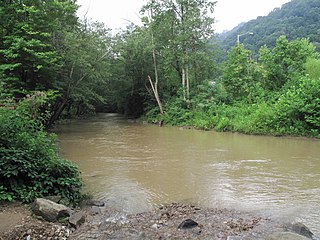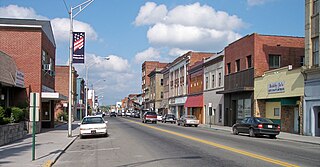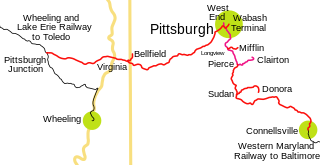The Kanawha and Pocahontas Railroad Company was incorporated in West Virginia in 1898 by either a son or the estate of Charles Pratt to reach new coal mining territory on land which was owned and/or leased by Gallego Coal & Land Company, Charles Pratt and Company, and other investors based in New York City. [1] [2]

West Virginia is a state located in the Appalachian region in the Southern United States that is also considered to be a part of the Middle Atlantic States. It is bordered by Pennsylvania to the north, Maryland to the east and northeast, Virginia to the southeast, Kentucky to the southwest, and Ohio to the northwest. West Virginia is the 41st largest state by area, and is ranked 38th in population. The capital and largest city is Charleston.

Charles Pratt was an American businessman and philanthropist. Pratt was a pioneer of the U.S. petroleum industry, and he established his kerosene refinery Astral Oil Works in Brooklyn, New York. He then lived with his growing family in Clinton Hill, Brooklyn. He recruited Henry H. Rogers into his business, forming Charles Pratt and Company in 1867. Seven years later, Pratt and Rogers agreed to join John D. Rockefeller's Standard Oil.

Coal is a combustible black or brownish-black sedimentary rock, formed as rock strata called coal seams. Coal is mostly carbon with variable amounts of other elements; chiefly hydrogen, sulfur, oxygen, and nitrogen. Coal is formed if dead plant matter decays into peat and over millions of years the heat and pressure of deep burial converts the peat into coal. Vast deposits of coal originates in former wetlands—called coal forests—that covered much of the Earth's tropical land areas during the late Carboniferous (Pennsylvanian) and Permian times.
The line was constructed in 1902 as a narrow gauge railroad and originated at the mainline of the Chesapeake and Ohio Railway (C&O) at what was called Paint Creek Junction along the Kanawha River. It ran 14 miles (23 km) along a tributary of the river called Paint Creek to Kingston, crossing the Kanawha-Fayette county line about one mile south of Burnwell.

The Chesapeake and Ohio Railway was a Class I railroad formed in 1869 in Virginia from several smaller Virginia railroads begun in the 19th century. Led by industrialist Collis P. Huntington, it reached from Virginia's capital city of Richmond to the Ohio River by 1873, where the railroad town of Huntington, West Virginia was named for him.

The Kanawha River is a tributary of the Ohio River, approximately 97 mi (156 km) long, in the U.S. state of West Virginia. The largest inland waterway in West Virginia, its valley has been a significant industrial region of the state since early in the 19th century.

Paint Creek is a 42.1-mile (67.8 km) tributary of the Kanawha River in southern West Virginia. Paint Creek is part of the Mississippi River watershed via the Kanawha and Ohio Rivers and drains an area of 123 square miles (320 km2).
Represented by attorney (and former West Virginia governor) William A. MacCorkle, industrialist Henry Huttleston Rogers, acting on behalf of Charles Pratt and Company, negotiated its lease of the entire line to the C&O. It later came under ownership of the C&O, and was later known as the C&O's Paint Creek Branch. [2]

William Alexander MacCorkle, was a United States teacher, lawyer, prosecutor, the ninth Governor of West Virginia and state legislator of West Virginia, and financier.
Charles Pratt and Company was an oil company that was formed in 1867 by Charles Pratt and Henry H. Rogers in Brooklyn, New York. It became part of John D. Rockefeller's Standard Oil organization in 1874.
(EDIT) There is no proof that HH Rogers was involved in this project. Gov. MacCorkle in his book (pp 412) relates that he talked with Rogers about this later and that Rogers thought that it was a blunder by the Pratt interests to sell this property. (TWS)
Around the same time, Henry Rogers was also involved with another nearby short-line railroad, the Deepwater Railway, which ran up Loup Creek in Fayette County. It also connected with the C&O along the Kanawha River, and was run by the C&O in its early years. However, the Deepwater Railway, headed by mining manager and developer William Nelson Page, and funded by Rogers, was eventually extended east to the West Virginia-Virginia state line, at which point it connected with the new Tidewater Railway, a line which Page and Rogers built to connect all the way east across Virginia to a new coal pier at Sewell's Point in the harbor of Hampton Roads. In 1907, they were combined to form the Virginian Railway, now a portion of the Norfolk Southern Railway.
The Deepwater Railway was an intrastate short line railroad located in West Virginia in the United States which operated from 1898 to 1907.

William Nelson Page was an American civil engineer and industrialist. He was active in the Virginias following the U.S. Civil War. Page was widely known as a metallurgical expert by other industry leaders and investors as well as state and federal authorities.

Virginia, officially the Commonwealth of Virginia, is a state in the Southeastern and Mid-Atlantic regions of the United States located between the Atlantic Coast and the Appalachian Mountains. Virginia is nicknamed the "Old Dominion" due to its status as the first English colonial possession established in mainland North America and "Mother of Presidents" because eight U.S. presidents were born there, more than any other state. The geography and climate of the Commonwealth are shaped by the Blue Ridge Mountains and the Chesapeake Bay, which provide habitat for much of its flora and fauna. The capital of the Commonwealth is Richmond; Virginia Beach is the most populous city, and Fairfax County is the most populous political subdivision. The Commonwealth's estimated population as of 2018 is over 8.5 million.












